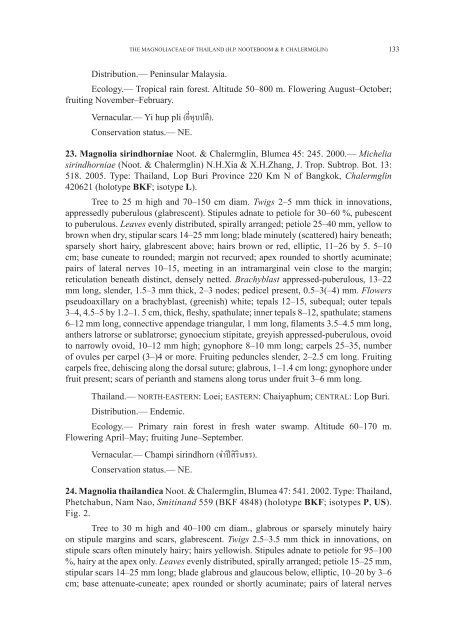Create successful ePaper yourself
Turn your PDF publications into a flip-book with our unique Google optimized e-Paper software.
THE MAGNOLIACEAE OF <strong>THAI</strong>LAND (H.P. NOOTEBOOM & P. CHALERMGLIN)<br />
Distribution.— Peninsular Malaysia.<br />
Ecology.— Tropical rain forest. Altitude 50–800 m. Flowering August–October;<br />
fruiting November–February.<br />
Vernacular.— Yi hup pli (ยี่หุบปลี).<br />
Conservation status.— NE.<br />
23. Magnolia sirindhorniae Noot. & Chalermglin, Blumea 45: 245. 2000.— Michelia<br />
sirindhorniae (Noot. & Chalermglin) N.H.Xia & X.H.Zhang, J. Trop. Subtrop. Bot. 13:<br />
518. 2005. Type: Thailand, Lop Buri Province 220 Km N of Bangkok, Chalermglin<br />
420621 (holotype BKF; isotype L).<br />
Tree to 25 m high and 70–150 cm diam. Twigs 2–5 mm thick in innovations,<br />
appressedly puberulous (glabrescent). Stipules adnate to petiole for 30–60 %, pubescent<br />
to puberulous. Leaves evenly distributed, spirally arranged; petiole 25–40 mm, yellow to<br />
brown when dry, stipular scars 14–25 mm long; blade minutely (scattered) hairy beneath;<br />
sparsely short hairy, glabrescent above; hairs brown or red, elliptic, 11–26 by 5. 5–10<br />
cm; base cuneate to rounded; margin not recurved; apex rounded to shortly acuminate;<br />
pairs of lateral nerves 10–15, meeting in an intramarginal vein close to the margin;<br />
reticulation beneath distinct, densely netted. Brachyblast appressed-puberulous, 13–22<br />
mm long, slender, 1.5–3 mm thick, 2–3 nodes; pedicel present, 0.5–3(–4) mm. Flowers<br />
pseudoaxillary on a brachyblast, (greenish) white; tepals 12–15, subequal; outer tepals<br />
3–4, 4.5–5 by 1.2–1. 5 cm, thick, fleshy, spathulate; inner tepals 8–12, spathulate; stamens<br />
6–12 mm long, connective appendage triangular, 1 mm long, filaments 3.5–4.5 mm long,<br />
anthers latrorse or sublatrorse; gynoecium stipitate, greyish appressed-puberulous, ovoid<br />
to narrowly ovoid, 10–12 mm high; gynophore 8–10 mm long; carpels 25–35, number<br />
of ovules per carpel (3–)4 or more. Fruiting peduncles slender, 2–2.5 cm long. Fruiting<br />
carpels free, dehiscing along the dorsal suture; glabrous, 1–1.4 cm long; gynophore under<br />
fruit present; scars of perianth and stamens along torus under fruit 3–6 mm long.<br />
Thailand.— NORTH-EASTERN: Loei; EASTERN: Chaiyaphum; CENTRAL: Lop Buri.<br />
Distribution.— Endemic.<br />
Ecology.— Primary rain forest in fresh water swamp. Altitude 60–170 m.<br />
Flowering April–May; fruiting June–September.<br />
Vernacular.— Champi sirindhorn (จำปี สิรินธร).<br />
Conservation status.— NE.<br />
24. Magnolia thailandica Noot. & Chalermglin, Blumea 47: 541. 2002. Type: Thailand,<br />
Phetchabun, Nam Nao, Smitinand 559 (BKF 4848) (holotype BKF; isotypes P, Us).<br />
Fig. 2.<br />
Tree to 30 m high and 40–100 cm diam., glabrous or sparsely minutely hairy<br />
on stipule margins and scars, glabrescent. Twigs 2.5–3.5 mm thick in innovations, on<br />
stipule scars often minutely hairy; hairs yellowish. Stipules adnate to petiole for 95–100<br />
%, hairy at the apex only. Leaves evenly distributed, spirally arranged; petiole 15–25 mm,<br />
stipular scars 14–25 mm long; blade glabrous and glaucous below, elliptic, 10–20 by 3–6<br />
cm; base attenuate-cuneate; apex rounded or shortly acuminate; pairs of lateral nerves<br />
133
















